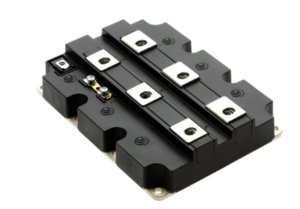
Insulated Gate Bipolar Transistor (IGBT) modules are pivotal in modern power electronics, combining the high-speed switching of MOSFETs with the high-current handling capabilities of bipolar junction transistors (BJTs). These modules are integral in applications requiring efficient power control, such as electric vehicles (EVs), renewable energy systems, and industrial motor drives. By enabling precise control over high voltages and currents, IGBT modules have largely replaced older technologies like thyristors in many high-power applications.
Table of Contents
ToggleStructure and Working Principle
Anatomy of an IGBT Module
An IGBT module is a sophisticated assembly of multiple components:
- IGBT and Diode Chips: Silicon-based dies that handle switching and freewheeling currents.
- Direct Bonded Copper (DBC) Substrate: A ceramic layer (Al₂O₃ or AlN) sandwiched between copper layers, providing electrical isolation and thermal conductivity.
- Baseplate: Typically copper or aluminum, it dissipates heat to the heatsink.
- Terminals: High-current connectors for power and gate signals.
- Encapsulation: Epoxy resin protects internal components from environmental factors.
Working Principle
IGBTs operate by modulating conductivity through a voltage-controlled gate:
- Turn-On: A positive gate-emitter voltage (typically +15V) forms a conductive channel, allowing electrons to flow. This triggers hole injection from the collector, enabling high current flow with low voltage drop.
- Turn-Off: Applying a negative voltage (-5V to -15V) depletes the channel, ceasing current flow. A “tail current” persists briefly due to stored charge, impacting switching losses.
Key Features of IGBT Modules
- High Voltage & Current Ratings: Capable of handling up to 6.5 kV and hundreds of amps.
- Efficiency: Low conduction losses (1.5–3V drop) at high voltages.
- Switching Speed: Moderate frequencies (1–100 kHz), balancing losses and performance.
- Thermal Resilience: Operates up to 150°C, aided by robust thermal management.
- Reliability: Designed for long-term use in demanding environments.
Comparison with MOSFETs and BJTs:
- IGBTs excel in high-voltage, medium-frequency applications (e.g., inverters).
- MOSFETs suit low-voltage, high-frequency uses (e.g., SMPS).
- BJTs are less efficient due to higher conduction losses.
Applications of IGBT Modules
- Electric Vehicles: Inverters convert battery DC to motor AC, enabling variable speed control.
- Renewable Energy: Solar/wind inverters interface with grids, optimizing power output.
- Industrial Drives: Adjustable speed drives (ASDs) enhance motor efficiency.
- Consumer Electronics: Inverter-based appliances (e.g., air conditioners) save energy.
- Rail Transport: Traction systems in trains and trams.
- Power Transmission: HVDC systems use IGBT-based voltage source converters (VSCs).
Advantages and Disadvantages
Pros:
- High power handling with low losses.
- Simplified gate driving vs. BJTs.
- Compact, modular design.
Cons:
- Switching losses at high frequencies.
- Tail current during turn-off.
- Higher cost than MOSFETs for low-voltage uses.
Selection Criteria
- Voltage/Current Ratings: Exceed system maxima by 20–30% for safety.
- Switching Frequency: Opt for MOSFETs above 100 kHz.
- Thermal Resistance: Lower junction-to-case (RθJC) values improve heat dissipation.
- Package: Modules vary in size (e.g., 62mm, 34mm) for different power levels.
- Cost: Balance performance needs with budget constraints.
Installation and Maintenance
- Mounting: Use thermal interface materials (TIMs) and proper torque to avoid cracks.
- Cooling: Active cooling (fans/liquid) for high-power applications.
- Gate Drivers: Ensure isolated drivers with fast rise/fall times.
- Maintenance: Monitor temperatures, inspect for solder fatigue, and test insulation resistance periodically.
Common Failures:
- Overvoltage/overcurrent (use snubbers/protection circuits).
- Thermal runaway (implement temperature sensing).
- Bond wire lift-off (due to thermal cycling).
Market Trends and Innovations
- Wide-Bandgap (WBG) Devices: Silicon carbide (SiC) and gallium nitride (GaN) challenge IGBTs in efficiency but remain cost-prohibitive for high-power uses.
- Intelligent Power Modules (IPMs): Integrate drivers and protection, reducing design complexity.
- RC-IGBTs: Combine IGBT and diode functions, cutting module size/cost.
- Market Growth: Driven by EVs and renewables, the IGBT market is projected to exceed $10 billion by 2027 (CAGR ~8%).
Conclusion
IGBT modules remain indispensable in high-power electronics, offering unmatched efficiency and reliability. While emerging technologies like SiC gain traction, IGBTs continue to evolve, cementing their role in sustainable energy and transportation. Engineers must weigh application requirements against device capabilities to optimize performance and cost.
Leading Manufacturers: Infineon, Mitsubishi Electric, Fuji Electric, Semikron.
This guide underscores the technical nuances and practical considerations vital for leveraging IGBT modules effectively in modern systems.
- Everything You Need To Know About Limit Switch - May 21, 2025
- Everthing You Should Know About Rheostat - May 20, 2025
- Everything You Need To Know About Reversing Contactor - May 19, 2025






